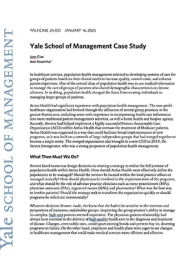Orange Grove Bio

In late 2023, Orange Grove Bio co-founder and CEO Marc Appel considered the future of his private drug development investment firm. Orange Grove Bio, (OGB) had finished its fourth- year nurturing promising early-stage drugs for new treatments of cancer, autoimmune, and inflammatory disease. The possibility of an influx of new capital was good. The company was thinking about launching additional rounds of private equity financing. Furthermore, Appel expected three of its portfolio companies to be cleared by the Federal Drug Administration for initial tests on people by 2025.
Teleconferencing with his executive team, CEO Appel gamed out possible future strategic directions for OGB. One possibility was building the company’s infrastructure. OGB could buy a contract research organization (CRO) to do bench work, sift through enormous data sets from lab tests, and conduct animal and human clinical trials on novel therapeutics. Having this technology in-house instead of paying outside companies for it would expand OGB’s capabilities and cut costs. Or the company could simply invest in building more wet labs for its portfolio companies.
Another possibility was building more relationships to increase OGB’s pipeline. The company had been built on the premise that valuable research to in-license was being ignored in universities located away from the biotech hot spots of Boston and San Francisco. OGB had invested in establishing connections with scientists in universities away from these locations, and even moved its headquarters to Cincinnati to take advantage of this opportunity. The team also had started looking internationally, considering relationships with universities and biotech firms outside the United States. However, creating productive alliances required resources and time. OGB had to consider the importance not only of the breadth but also the depth of its scientific alliances.
Appel also discussed the idea of starting an associated venture capital fund to leverage the firm’s relationships with investors and drug companies. OGB had been established to nurture promising scientific work ready for clinical trials on people. Its business model was to in-license biological discoveries from academia to build businesses around, with the plan of selling these for large profits to pharmaceutical companies when the underlying molecules showed promise of improving human health in tests on people. The company could also look further ahead in the development cycle and in-license medicines approaching the end of human clinical testing and possibly reap profits on the next blockbuster drug.
Or the company, for now, could just stand on its original business model and develop its existing portfolio of eight early-stage, preclinical subsidiaries. What would attract the most investor interest? OGB was building toward an eventual IPO, but in 2023, market conditions for biotech firms were deteriorating. The U.S. S&P 500 Biotechnology Industry index fell 50 percent in the third quarter of 2023 from its high in 2021.5 The sector was in its worst shape in 20 years, some analysts said. And venture capital funding had sunk to a six-year low amid worries about high interest rates and inflation. Given the market conditions, what would be the smartest move?